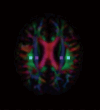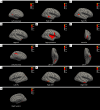Association of magnetic resonance imaging glymphatic function with gray matter volume loss and cognitive impairment in Alzheimer's disease: a diffusion tensor image analysis along the perivascular space (DTI-ALPS) study
- PMID: 40727340
- PMCID: PMC12290719
- DOI: 10.21037/qims-2025-96
Association of magnetic resonance imaging glymphatic function with gray matter volume loss and cognitive impairment in Alzheimer's disease: a diffusion tensor image analysis along the perivascular space (DTI-ALPS) study
Abstract
Background: Diffusion tensor image analysis along the perivascular space (DTI-ALPS) has been used for diagnosing Alzheimer's disease (AD); however, few studies have examined the relationship between the DTI-ALPS index and cortical metrics, and the differentiation between AD severity levels remains unclear. This study aimed to explore the differences in DTI-ALPS index and cortex among AD patients with varying severities and to analyze the interactions between DTI-ALPS index, cortical metrics, and cognitive function.
Methods: A total of 19 individuals with mild cognitive impairment (MCI), 17 individuals exhibiting mild AD, 25 individuals with moderate AD, and 28 healthy controls (HC) who were matched for age, sex, and education level were recruited. All the participants underwent diffusion tensor imaging (DTI) magnetic resonance imaging (MRI), followed by the calculation of the DTI-ALPS index to assess lymphatic system function. FreeSurfer (v7.4.1) was used to calculate thickness, volume, local gyre index, and area. One-way analysis of variance (ANOVA) was performed to compare the differences among HC, MCI, mild AD, and moderate AD groups. Pearson correlation analysis was employed to investigate the connection between the DTI-ALPS index and cognitive function, along with cortical metrics.
Results: The HC, MCI, mild AD, and moderate AD groups exhibited significant differences in the DTI-ALPS index of the left hemisphere (P=0.008), whereas 13 cortical metrics revealed a statistical significance between groups (P<0.05). In the left hemisphere, the DTI-ALPS index showed a positive trend with the Montreal Cognitive Assessment (MoCA) score (r=0.397, P<0.001). Higher DTI-ALPS was also associated with an increase in 10 cortical metrics after controlling for age, sex, and education.
Conclusions: There is a significant relationship between the DTI-ALPS index, cortical metrics, and cognitive function. This result may suggest that lymphatic dysfunction indicated by the DTI-ALPS index could mirror cortical structural degeneration and cognitive decline within the pathological process of AD. DTI-ALPS can be used as an indicator of structural degeneration and decline in cognitive function in AD.
Keywords: Alzheimer’s disease (AD); cerebral cortex; cortical index; diffusion magnetic resonance imaging (diffusion MRI); glymphatic system (GS).
Copyright © 2025 AME Publishing Company. All rights reserved.
Conflict of interest statement
Conflicts of Interest: All authors have completed the ICMJE uniform disclosure form (available at https://qims.amegroups.com/article/view/10.21037/qims-2025-96/coif). X.Y.L. reports that he was employed by Neusoft Medical Systems Co., Ltd. The other authors have no conflicts of interest to declare.
Figures






Similar articles
-
Noninvasive assessment of glymphatic dysfunction and IDH mutation in glioma with DTI-ALPS and DTI metrics.Quant Imaging Med Surg. 2025 Jun 6;15(6):5007-5022. doi: 10.21037/qims-2024-2710. Epub 2025 May 19. Quant Imaging Med Surg. 2025. PMID: 40606349 Free PMC article.
-
Diffusion tensor image analysis along the perivascular space index and visual analogue scales in female patients with patent foramen ovale and migraine perform better after percutaneous closure.Quant Imaging Med Surg. 2025 Aug 1;15(8):6969-6980. doi: 10.21037/qims-2025-265. Epub 2025 Jul 30. Quant Imaging Med Surg. 2025. PMID: 40785935 Free PMC article.
-
Diffusion Tensor Imaging Along the Perivascular Space for Characterizing Cerebral Interstitial Fluid Dynamics in Alzheimer's Disease: A Systematic Review and Meta-Analysis.AJNR Am J Neuroradiol. 2025 Aug 4:ajnr.A8953. doi: 10.3174/ajnr.A8953. Online ahead of print. AJNR Am J Neuroradiol. 2025. PMID: 40759558 Review.
-
MRI free water mediates the association between diffusion tensor image analysis along the perivascular space and executive function in four independent middle to aged cohorts.Alzheimers Dement. 2025 Feb;21(2):e14453. doi: 10.1002/alz.14453. Epub 2024 Dec 30. Alzheimers Dement. 2025. PMID: 39740225 Free PMC article.
-
Plasma and cerebrospinal fluid amyloid beta for the diagnosis of Alzheimer's disease dementia and other dementias in people with mild cognitive impairment (MCI).Cochrane Database Syst Rev. 2014 Jun 10;2014(6):CD008782. doi: 10.1002/14651858.CD008782.pub4. Cochrane Database Syst Rev. 2014. PMID: 24913723 Free PMC article.
References
-
- Iliff JJ, Wang M, Liao Y, Plogg BA, Peng W, Gundersen GA, Benveniste H, Vates GE, Deane R, Goldman SA, Nagelhus EA, Nedergaard M. A paravascular pathway facilitates CSF flow through the brain parenchyma and the clearance of interstitial solutes, including amyloid β. Sci Transl Med 2012;4:147ra111. 10.1126/scitranslmed.3003748 - DOI - PMC - PubMed
-
- Lee S, Yoo RE, Choi SH, Oh SH, Ji S, Lee J, Huh KY, Lee JY, Hwang I, Kang KM, Yun TJ, Kim JH, Sohn CH. Contrast-enhanced MRI T1 Mapping for Quantitative Evaluation of Putative Dynamic Glymphatic Activity in the Human Brain in Sleep-Wake States. Radiology 2021;300:661-8. 10.1148/radiol.2021203784 - DOI - PubMed
LinkOut - more resources
Full Text Sources
